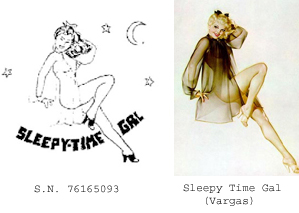TTAB Gives Thumbs Up To WW2 Pin-Up Nose Art
The TTAB has reversed seven Section 2(a) refusals to register black-and-white drawings of Second World War airplane "nose art" as trademarks for printed matter, including posters and greeting cards. In re American Airpower Heritage Museum, Serial Nos. 76144075 et al. (November 18, 2004) [not citable].

The Examining Attorney contended that each of the marks falsely suggests a connection with pin-up artists Alberto Vargas (four marks) or Gil Elvgren (three). She submitted Internet evidence regarding World War II "nose art" and its sources, and copies of particular paintings by Vargas or Elvgren corresponding to each mark.
The Board cited Univ. of Notre Dame du Lac v. J.C. Gourmet Food Imports Co., 217 USPQ 505 (Fed. Cir. 1983) for a list of the elements necessary to establish a false-suggestion-of-a-connection claim under Section 2(a): it must be shown that (1) applicant's mark is the same as or a close approximation of the person's previously used name or identity; (2) the mark points uniquely and unmistakably to that person; (3) the person is not connected with the applicant; and (4) the person's name or identity is of sufficient fame that, when used in connection with Applicant's goods, a connection with that person would be presumed by customers. Here, three of the four requirements were not satisfied.
The Board concluded that the first element was not met because "there is scant evidence that the 'pin-up girl' painting(s) of either Vargas or Elvgren amounted to the artist's name or identity in the minds of consumers."
"The fact that one artist paints a particular picture which another artist copies to some degree does not establish that the original particular picture amounts to that artists's name or identity."As to the second element, "the record clearly does not establish that 'pin-up girl' art in general is uniquely and unmistakably associated with either artist, Vargas or Elvgren." Numerous artists were involved in painting "pin-up girls," particularly in the 1940s, when Applicant's "nose art" designs were originally painted on airplanes.
The third element was met because Applicant and the two artists are not connected.
The fourth requirement was not satisfied because there was no evidence that the particular paintings that were the bases for the marks are "famous, and would be recognized by the purchasing public as identifying either Alberto Vargas or Gil Elvgren, such that a connection with the particular artist would be presumed."
Section 2(a) false connection refusals are seldom upheld, an exception being the citable APACHE case of a few months ago. In In re White, S.N. 78175476 (Sept. 8, 2004), the Board affirmed a Section 2(a) refusal to register the mark APACHE for cigarettes, finding that it falsely suggests a connection with the nine federally-recognized and variously-named Apache tribes.
In White, the Board applied its “fairly standard” analysis in ruling that APACHE “would be recognized as a name, or equivalent thereof, for each of the tribes;” that the mark points uniquely and unmistakably to the Apache tribes; that Applicant has no connection with the tribes; and that the name APACHE is of sufficient fame or reputation that a connection with the tribes would be presumed by consumers of cigarettes. The evidence showed that “Native Americans not only are engaged in large-scale marketing of cigarettes, but in manufacturing of Native American brands of cigarettes.”




0 Comments:
Post a Comment
<< Home